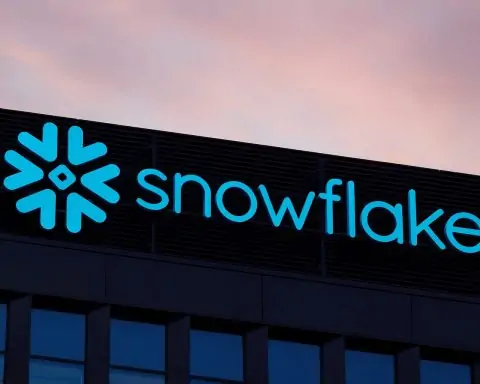- QQQ Performance: The Invesco QQQ Trust (Nasdaq-100 ETF) fell about 3.5% on Friday, Oct 10 (its steepest drop in months) as Trump renewed China tariff threats, but it’s still up roughly 15–16% year-to-date [1]. Early Monday (Oct 13) futures show QQQ bouncing ~1.8% after Trump’s weekend assurances that “trade relations…will all be fine” [2] [3].
- TQQQ Frenzy: ProShares UltraPro QQQ (TQQQ), the 3× leveraged Nasdaq-100 ETF, saw trading volume surge 75% amid the October volatility [4]. Despite a ~10.5% slide on Friday (closing around $97), TQQQ is up ~37% YTD [5] [6]. This huge run-up has prompted profit-taking – TQQQ has experienced net outflows of about $7 billion in 2025 so far [7] – as retail traders cash in gains.
- Macro Drivers: Markets were roiled by U.S.-China trade fears and an ongoing government shutdown (Day 13). Friday’s selloff came after Trump threatened 100% tariffs on Chinese imports, sending the S&P 500 and Nasdaq indexes to their largest weekly losses in months [8] [9]. Over the weekend Trump eased his tone (“will all be fine”), lifting futures sharply [10] [11]. Other factors include Middle East developments (a Gaza ceasefire helped send oil prices lower) [12], and new U.S. tax adjustments for 2026 (raised deductions and brackets) that could boost consumer spending [13].
- Analyst Sentiment: Experts remain broadly bullish on QQQ. TipRanks labels QQQ a “Moderate Buy” with a consensus target of about $675 (roughly +14–15% upside from current levels) [14]. Its TipRanks SmartScore is 8/10, implying it “is likely to outperform” the broader market [15]. Even UBS analysts say “the bull market remains intact” and recommend using pullbacks as buying opportunities [16]. Big banks have raised targets (Goldman’s S&P 500 target is ~6800) on hopes of Fed support [17].
- Cautions & Rotations: At the same time, caution is growing. Tech valuations are seen as “frothy” by the Bank of England, and one manager warns the AI-fueled rally is like a wave that “will eventually crest and decline” [18]. TS2.tech notes QQQ is a “cautionary example” of a high-concentration tech ETF – it’s heavily weighted in a few giants [19]. Retail traders have begun rotating into safer assets: gold hit all-time highs (~$4,000/oz) on a flight to safety [20], and many are hedging stock risk. As one strategist observed, markets now seem to be “teetering on that fine line” between buoyant gains and a pullback [21].
Market Recap: Trade Truce Sends QQQ Higher
QQQ, the Nasdaq-100 ETF, tracks the 100 largest non-financial companies on Nasdaq (heavy in Apple, Microsoft, Amazon, etc.) [22]. On Friday Oct 10, QQQ plunged ~3.5% as President Trump announced plans to double tariffs on Chinese imports and restrict rare-earth exports, renewing trade war fears [23] [24]. This knocked major tech shares lower (for example, Friday’s Nasdaq Composite lost ~820 points) and dragged QQQ to a 5-day decline of about 2.9% [25]. Over the weekend Trump backpedaled, tweeting that he didn’t want to “hurt” China and that things would be fine, which soothed investors. On Monday, futures were up: Nasdaq 100 futures jumped ~1.8% by Monday morning [26]. TipRanks notes that as of pre-market Mon Oct 13, QQQ was up around 1.8% [27], recouping some losses. This volatility reflects how sensitive QQQ is to geopolitics – after all, even though QQQ is up ~16% YTD, a single weekend tweet moved it several percent.
Tech ETF Rally & Investor Profit-Taking
The frenzy was even bigger in leveraged tech ETFs. TQQQ – which aims for 3× daily Nasdaq-100 returns – saw a record jump in volume (up 75%) on the surge in tech optimism [28]. TQQQ is wildly volatile: it surged ~37% in 2025 but gave up about 10.5% on Friday [29] [30]. As Meyka reports, strong tech earnings and a bullish market mood have driven traders to such leveraged vehicles for big short-term gains [31] [32]. However, many fast-money traders then took profits. TS2.tech highlights that September saw roughly $7 billion in outflows from leveraged ETFs – the largest on record – even as those funds hit new highs [33]. For example, TQQQ alone lost about $7B in shares year-to-date, and its semiconductor counterpart SOXL lost ~$6.9B [34]. The explanation: these swingy ETFs often underperform their leverage due to daily rebalancing costs. TQQQ’s 37% gain this year equates to only ~1.9× the Nasdaq’s 20% gain (not 3×) [35]. Many traders saw “only” double returns instead of triple and decided to lock in gains [36] [37].
In short, trading psychology flipped from greed to prudence in recent weeks. TS2 points out that dip-buyers who piled into TQQQ after 2022’s crash are now “taking the money and running” after the rally [38] [39]. Even institutional managers note that leveraged ETFs are often held only short-term. With funding costs up (higher interest rates) and expense ratios near 0.82%, holding TQQQ long-term is “not cheap” [40]. Retail traders have been trimming exposure across risky assets, from tech stocks to crypto, perhaps sensing it’s time to secure profits [41] [42]. Indeed, as one Lido Advisors strategist put it: “We’re teetering on that fine line, when does bad data become bad for the markets?” [43] – suggesting the run-up could stall if any negative surprise hits.
Political & Economic Drivers
Several cross-currents shaped the mood. Beyond the U.S.-China trade news, the U.S. government shutdown (now day 13 as of Oct 13) looms as an overhang. Although markets mostly shrugged it off initially, the political deadlock adds uncertainty to economic policy. Meanwhile, October earnings season kicks off – analysts expect S&P 500 profits to grow ~8.8% year-over-year [44] – which could fuel or dent the rally when banks like JPMorgan and Goldman (reporting Oct 14–15) post results.
On the global front, geopolitical shifts are easing one risk even as others persist. A tentative Gaza ceasefire lowered oil prices, shaving off a “security premium” from markets [45]. In Europe, political turmoil (e.g. France’s budget wrangling) has put pressure on the euro, which can sway multinational tech firms’ sales overseas.
Domestically, policy changes may offer tailwinds. The IRS announced that starting 2026, higher standard deductions and broader tax brackets will give consumers more disposable income [46]. That is expected to bolster spending on durables and personal goods, indirectly supporting corporate earnings. On interest rates, Fed officials are signaling a delicate balance: St. Louis Fed’s Musalem said he’s “open-minded about a potential” further rate cut to cushion labor markets but cautioned that inflation is still above target [47]. Futures markets are currently pricing in likely quarter-point cuts at the Fed’s Oct and Dec meetings, reflecting hopes for easier policy. Economist Jeremy Siegel argues that disinflation combined with steady growth is “a recipe for the Fed to continue easing,” which could be bullish for stocks [48]. Nevertheless, investors remain alert: they’ve been rotating into defensive assets – gold surged to ~$4,000 (up ~53% YTD) – as a hedge [49], and many are raising cash or buying volatility insurance in case the party cools.
Analyst Forecasts & Outlook
Despite short-term swings, most analysts still favor QQQ’s longer-term trend. TipRanks’ aggregated data shows analysts have a consensus 12-month price target of ~$674 for QQQ [50] (implying about +14% upside). The consensus rating is “Moderate Buy,” and QQQ’s TipRanks SmartScore of 8/10 suggests it “is likely to outperform” the broader market [51]. This optimism is rooted in tech’s robust earnings (Apple, Microsoft, Nvidia, etc. continue to grow) and the belief that eventual Fed rate cuts could fuel another leg of the rally [52] [53]. UBS analysts explicitly note that after last week’s dip, they see buying opportunities, stating bluntly that “the bull market remains intact” and advising investors to add exposure on weakness [54].
Still, experts urge caution given elevated valuations. As noted, leveraged ETFs like TQQQ carry hidden decay, and high-flying tech stocks may be due for a breather. A TS2.tech report cites the Bank of England’s warning that AI-related tech names look especially “frothy” and could correct sharply [55]. In fact, TS2 reminds investors of common ETF pitfalls: chasing past performance or niche trends (e.g. the GLP-1 craze) can backfire. Specifically, TS2 says QQQ itself is concentrated – if you bet heavily on QQQ, you’re really concentrated on a handful of mega-cap tech firms [56]. Missing a window to sell in such an environment can hurt: “pigs who stay too long get slaughtered,” as the adage goes [57].
Bottom line: The Nasdaq 100 and its ETFs sit at a crossroads. In the near term, QQQ’s trajectory will hinge on trade talks, Fed signals, and how October’s earnings pan out. If tariffs remain off the table and policy stays accommodative, the tech rally could resume (and TipRanks’ upside cases may play out). But if inflation or politics throw a curveball, we could see renewed pressure. For now, most strategists suggest balanced optimism: enjoy the gains, but keep risk in check. As UBS advises, view pullbacks as buying opportunities, but remember Dillon’s cautionary words that we’re “teetering on that fine line” – meaning any bad news could flip sentiment quickly [58] [59].
Sources: Market data and analysis from TipRanks [60] [61], Reuters [62] [63], TS2.tech [64] [65], Azat TV [66] [67], Meyka [68] [69], and related financial news outlets.
References
1. www.tipranks.com, 2. www.tipranks.com, 3. www.reuters.com, 4. meyka.com, 5. meyka.com, 6. ts2.tech, 7. ts2.tech, 8. www.tipranks.com, 9. www.reuters.com, 10. www.tipranks.com, 11. www.reuters.com, 12. azat.tv, 13. azat.tv, 14. www.tipranks.com, 15. www.tipranks.com, 16. www.reuters.com, 17. ts2.tech, 18. ts2.tech, 19. ts2.tech, 20. ts2.tech, 21. ts2.tech, 22. azat.tv, 23. www.tipranks.com, 24. www.reuters.com, 25. www.tipranks.com, 26. www.reuters.com, 27. www.tipranks.com, 28. meyka.com, 29. meyka.com, 30. ts2.tech, 31. meyka.com, 32. meyka.com, 33. ts2.tech, 34. ts2.tech, 35. ts2.tech, 36. ts2.tech, 37. ts2.tech, 38. ts2.tech, 39. ts2.tech, 40. ts2.tech, 41. ts2.tech, 42. ts2.tech, 43. ts2.tech, 44. www.reuters.com, 45. azat.tv, 46. azat.tv, 47. www.reuters.com, 48. ts2.tech, 49. ts2.tech, 50. www.tipranks.com, 51. www.tipranks.com, 52. www.reuters.com, 53. ts2.tech, 54. www.reuters.com, 55. ts2.tech, 56. ts2.tech, 57. ts2.tech, 58. www.reuters.com, 59. ts2.tech, 60. www.tipranks.com, 61. www.tipranks.com, 62. www.reuters.com, 63. www.reuters.com, 64. ts2.tech, 65. ts2.tech, 66. azat.tv, 67. azat.tv, 68. meyka.com, 69. meyka.com







